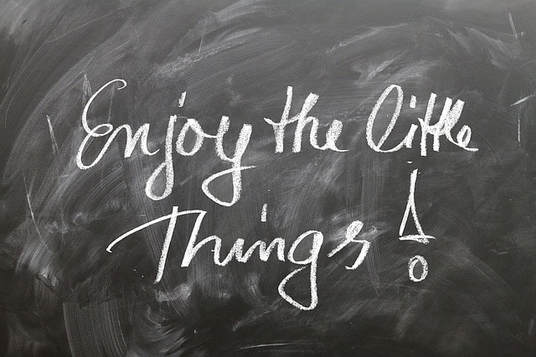Think Positive: 16 Simple Ways to Start Thinking Positive*This page may include affiliate links; that means I earn from qualifying purchases of products.
When you think positive you just can't help but be optimistic, even when everyone around you is miserable. As a result, you are happier and more satisfied with your life. The benefits of positive thinking are vast. So how do you get your stubborn brain to start thinking positive?
1. Take the Well-Being Quiz to See How Positive You AreNot sure whether you're a negative nelly? Take this well-being quiz, which not only gives you a score on "positive thinking", it can help you identify whether you need to build other skills to improve your happiness and well-being.
Are You a Therapist, Coach, or Wellness Entrepreneur?
Grab Our Free eBook to Learn How to
|
|
Capitalizing, like savoring, helps you make the most of positive moments. To capitalize on positive emotions, show them, tell them, or share them with others right away.
Keep in mind that the positive thing that happens doesn’t have to be big. You could simply have woken up on the right side of the bed and think, “Hey, I’m feeling great today.” “Show it” by expressing the positive emotions in your facial expressions and body language. For example, you could smile, laugh, or throw your hands up in the air. These expressions of happiness can help prolong your positive feelings. |
“Tell it” by talking to someone about why you’re happy. You might call a friend to talk about what you’re feeling. Others tend to respond well to expressions of positive emotions (as long as you're not bragging), which can further generate more positive emotions for you.
“Share it” by sending a text or message to a friend. If there is something you are feeling great about, particularly something you think would make others feel great too, share it far and wide. Just be careful not to post things that might make other people feel worse (like if you got something that someone else wanted).
“Share it” by sending a text or message to a friend. If there is something you are feeling great about, particularly something you think would make others feel great too, share it far and wide. Just be careful not to post things that might make other people feel worse (like if you got something that someone else wanted).
6. Pay Attention to the Positive Things
Are you one of those people who gets stressed or notices the bad stuff—like when someone cuts you off in traffic or your meal doesn't taste as good as you wanted it too? Then you likely have trained your brain to focus on the negative, and your brain has gotten really good at it. It can be really challenging to undo this pattern in your brain and think positive.
You have to practice regularly directing your attention to positive information and stop focusing so much on the negative. That doesn't mean the negative will go away, but it wont bother you so much.
7. Create a Collection of Positive Images or Positive Quotes
Are you a visual person? Then perhaps it's easier to activate your positivity with positive images or positive quotes. Instead of activating positive regions of your brain with words, you can also activate your "positive brain" with images.
There are tons of positive images online, and you can use an online tool, like Pinterest, to collect images of people, places, or things that make you feel positive. These can be photos that you took, drawings, or other positive things you found online. Feel free to check out my Pinterest collection for inspiration.
There are tons of positive images online, and you can use an online tool, like Pinterest, to collect images of people, places, or things that make you feel positive. These can be photos that you took, drawings, or other positive things you found online. Feel free to check out my Pinterest collection for inspiration.
Another idea is to collect one image per day of something positive that makes you feel good. I recently discovered the app, 1 Second Everyday, which stitches snippets from your life into a personal movie. Use this app or just your cellphone camera to keep track of the good things.
8. Think Positive, but Think Negative When You Need To
Of course, thinking positive has many benefits for your mental health and well-being. But thinking positive isn't always the best response. Negative thoughts sometimes have benefits too.
When we are sad or grieving, thinking negative thoughts and showing negative emotions helps us communicate to others that we need their support. When we get angry, our thoughts can help motivate us to take action and make necessary changes in our lives. Casually pushing negative emotions aside without seriously considering what they are trying to tell us can have real consequences.
So when you focus on the negative, ask yourself: is this negative emotion resulting in action that improves your life? If so, then keep it. If not, then work on focusing on the positive.
When we are sad or grieving, thinking negative thoughts and showing negative emotions helps us communicate to others that we need their support. When we get angry, our thoughts can help motivate us to take action and make necessary changes in our lives. Casually pushing negative emotions aside without seriously considering what they are trying to tell us can have real consequences.
So when you focus on the negative, ask yourself: is this negative emotion resulting in action that improves your life? If so, then keep it. If not, then work on focusing on the positive.
9. Practice Gratitude To Think Positive
I'll be the first to admit that there are a lot of things to be angry, sad, or anxious about. But the truth is that there is also an infinite number of things to feel passionate, joyful, and excited about. It's up to us to decide which things, the positive or the negative, we want to focus on.
One way to train your brain to focus more on the positive things in life is to practice gratitude. Gratitude is when we feel or express thankfulness for the people, things, and experiences we have. When we express gratitude at work, we can more easily gain the respect and camaraderie of those we work with. When we are grateful for our partners or friends, they are more happy with us. When we are grateful for the little things in our day-to-day lives, we find more meaning and satisfaction in our lives.
One of the easiest ways to practice gratitude is by writing a list of all the things you are grateful for. Try to think of as many things, people, places, etc., as you can. (e.g., Your family, yummy ice cream, rainbows, puppies, etc.
Or you could write down three good things a few days per week. At the end of the week, review your list to remind yourself that you have a lot to be grateful for.
One way to train your brain to focus more on the positive things in life is to practice gratitude. Gratitude is when we feel or express thankfulness for the people, things, and experiences we have. When we express gratitude at work, we can more easily gain the respect and camaraderie of those we work with. When we are grateful for our partners or friends, they are more happy with us. When we are grateful for the little things in our day-to-day lives, we find more meaning and satisfaction in our lives.
One of the easiest ways to practice gratitude is by writing a list of all the things you are grateful for. Try to think of as many things, people, places, etc., as you can. (e.g., Your family, yummy ice cream, rainbows, puppies, etc.
Or you could write down three good things a few days per week. At the end of the week, review your list to remind yourself that you have a lot to be grateful for.
10. Share Your Gratitude With Others To Extend Positive Thoughts
To take your gratitude practice up a notch, you could send a gratitude letter or message to someone who you never properly thanked. Your letter could be about anything. Maybe you want to thank a friend for always being there for you. Or maybe you want to thank your romantic partner for a very specific experience, like a date. In your letter share your positive thoughts. Try to be specific and note why you value the other person, going beyond just the positive ways he or she makes you feel.
If this seems too intense, you can share your gratitude in smaller ways. Write out a few sticky notes to people who you are grateful for. Include one to two things you appreciate about them and stick the note on their desk, car, or bag. Or practice gratitude on social media by writing short positive messages to the people you feel most grateful for.
If this seems too intense, you can share your gratitude in smaller ways. Write out a few sticky notes to people who you are grateful for. Include one to two things you appreciate about them and stick the note on their desk, car, or bag. Or practice gratitude on social media by writing short positive messages to the people you feel most grateful for.
Each day for a week, write down three good things about your day. At the end of the week, review your list to remind you have to be grateful for.
11. Make a Gratitude Drawing To Think Positive With The Right Side of Your Brain
Perhaps you're not the list-writing type. That's okay. Take a moment to think of some of the people or things you are most grateful for. Then create a drawing that includes all these positive things. It doesn't need to be a good drawing. All you are doing is helping your brain recognize the positive things in your life. But if you like your drawing, put it up on the fridge to remind you of what you're grateful for and to keep the positive thoughts flowing.
12. Make Positive Emotions by Watching Positive Videos
The broaden-and-build theory of positive emotion suggests that experiencing positive emotions builds our psychological, intellectual, and social resources, allowing us to benefit more from our experiences. So how do we infuse our lives with small bursts of positive emotion?
One way is to watch positive or fun videos.
One way is to watch positive or fun videos.
Watching cute pet videos or inspirational videos can generate a quick boost of positive emotions that can fuel an upward spiral of positive emotions. Just be sure to mentally hang onto the positive emotions that emerge (with strategies like savoring) so that you take your good mood with you when you finish the video. And be careful not to get sucked in for too long, or you may end up feeling guilty for not spending your time in other ways.
Here's a video to help cultivate positive thoughts:
Here's a video to help cultivate positive thoughts:
13. Stop Minimizing Your Successes
We have this horrible habit of minimizing our successes. For example, we may say, “Anyone could start their own wellness business,” or “I didn’t increase my happiness as much I wanted to.” These phrases minimize your small successes instead of celebrating them. You focus on how good it could of been instead of focusing on how good it already is.
As you pursue positive thinking, happiness, or well-being—whatever your goal is—take note of your wins. For every small win, celebrate at least a little bit.
As you pursue positive thinking, happiness, or well-being—whatever your goal is—take note of your wins. For every small win, celebrate at least a little bit.
14. Create Positivity Triggers For Spontaneous Positive Thoughts
Did you know that you can create positivity triggers in your daily life? If you've ever taken an intro to psychology course, you've probably heard about the study of Pavlov's dog. Here is a quick refresher just in case:
Pavlov had a dog. Pavlov would ring a bell to tell his dog that it was almost feeding time. Like most dogs, Pavlov's dog would get really excited when he was about to get fed. So he'd drool all over the place.
What happened? Well, suddenly Pavlov's dog started getting excited just by the sound of that bell, even when food wasn't present. Eating food and the sound of the bell became linked in the dog’s brain. Something as meaningless as a bell was now making the dog excited.
This effect is called classical conditioning. It's the idea that when two stimuli are repeatedly paired, the response that was first elicited by the second stimulus (food) is now elicited by the first stimulus alone (the bell).
This happens all the time without us even realizing it. For example, for many of us, our favorite food is something that we ate as a child with our families. What likely happened was the positive feelings of being with family and the particular food got paired in our brains. As a result, we now get the warm-fuzzy feelings that we got from spending time with family just from eating the food alone, even if our family is not currently present when we eat it.
Pavlov had a dog. Pavlov would ring a bell to tell his dog that it was almost feeding time. Like most dogs, Pavlov's dog would get really excited when he was about to get fed. So he'd drool all over the place.
What happened? Well, suddenly Pavlov's dog started getting excited just by the sound of that bell, even when food wasn't present. Eating food and the sound of the bell became linked in the dog’s brain. Something as meaningless as a bell was now making the dog excited.
This effect is called classical conditioning. It's the idea that when two stimuli are repeatedly paired, the response that was first elicited by the second stimulus (food) is now elicited by the first stimulus alone (the bell).
This happens all the time without us even realizing it. For example, for many of us, our favorite food is something that we ate as a child with our families. What likely happened was the positive feelings of being with family and the particular food got paired in our brains. As a result, we now get the warm-fuzzy feelings that we got from spending time with family just from eating the food alone, even if our family is not currently present when we eat it.
If you know what you're doing, you can use this phenomenon to create triggers in your environment (like the bell) to boost your own positivity. You just do exactly what Pavlov did. You repeatedly link boring things (like a bell ringing) with positive thoughts and feelings over and over again. Eventually, these boring things will generate positivity automatically! That's classical conditioning at work.
This is a handy trick to help you think positivity because when you are going about your life, maybe even feeling bummed about stresses or challenges, you’ll have these little positive boosts that suddenly create positive emotions, keeping you in a good mood.
This is a handy trick to help you think positivity because when you are going about your life, maybe even feeling bummed about stresses or challenges, you’ll have these little positive boosts that suddenly create positive emotions, keeping you in a good mood.
15. Stop All-Or-Nothing Thinking
All-or-nothing thinking is when we see a situation as all good or all bad. This is a hard negative thinking habit to overcome. For example, you might think you're a complete failure because you are not as happy as you want to be.
Thinking positive is not all about ignoring the bad; it's about recognizing that there is some good in everything, even the bad. The world is not black or white. Recognizing the shades of grey helps us more easily make room for positive thoughts.
Thinking positive is not all about ignoring the bad; it's about recognizing that there is some good in everything, even the bad. The world is not black or white. Recognizing the shades of grey helps us more easily make room for positive thoughts.
16. Enjoy Your Life
Thinking positive shouldn't be a chore. Find ways to have fun with it. Play games, challenge yourself, make positive impacts in the world, and try new positive thinking strategies until you find what works best for you. And if you need help, we've got a Happiness Program that can keep you on track.
Want some more ways to think positive? Here are some more positive thinking videos:
The Power of Positive Thinking Audiobook:
Want some more ways to think positive? Here are some more positive thinking videos:
The Power of Positive Thinking Audiobook:
Don't Forget to Grab Our Free eBook to Learn How to
Grow Your Wellness Business Exponentially!
References:
- Davis, Tchiki S., B. Q. Ford, M. Riese, K. McRae, P. Zarolia, E. Butler, and I. B. Mauss. 2013. "Look on the bright side: Effects of positive reappraisal training on psychological health." Society for Personality and Social Psychology, Emotion Pre-Conference, New Orleans, LA.
- Emmons, Robert A., and Michael E. McCullough. 2003. "Counting blessings versus burdens: An experimental investigation of gratitude and subjective well-being in daily life." Journal of Personality and Social Psychology 84 (2):377-389.
- MacLeod, Colin, Elizabeth Rutherford, Lyn Campbell, Greg Ebsworthy, and Lin Holker. 2002. "Selective attention and emotional vulnerability: Assessing the causal basis of their association through the experimental manipulation of attentional bias." Journal of Abnormal Psychology 111 (1):107-123.
- Quoidbach, Jordi, Elizabeth V. Berry, Michel Hansenne, and Moïra Mikolajczak. 2010. "Positive emotion regulation and well-being: Comparing the impact of eight savoring and dampening strategies." Personality and Individual Differences 49 (5):368-373.
- Siegle, Greg J., Frank Ghinassi, and Michael E. Thase. 2007. "Neurobehavioral therapies in the 21st century: Summary of an emerging field and an extended example of cognitive control training for depression." Cognitive Therapy and Research 31 (2):235-262.
- Wadlinger, Heather A., and Derek M. Isaacowitz. 2008. "Looking happy: The experimental manipulation of a positive visual attention bias." Emotion 8 (1):121-126.













